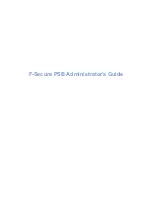
Symantec® ServiceDesk Customization Guide 7.0
64
z
Exception Component/Exception Trigger/Exception Trigger By Component/
Exception Trigger By Exception Type – These components are necessary for logging
and reporting on any exception or issue that occurs while your process is being run.
Removal of these will compromise your reporting capabilities as well as prevent you
from troubleshooting properly.
z
Add New Data Element – This component will most likely be configured so as to
create a variable which will be utilized throughout the process. Removing this
component will compromise the integrity of your project.
ServiceDesk 7 scalability
ServiceDesk 7 is a complex system built on the most scalable elements of the Symantec
software platform. There are several ways to configure ServiceDesk based on the needs
of a particular organization. ServiceDesk supports simple configurations where one
server provides all of the ServiceDesk capability and complex configurations that use
clustering and load balancing technologies.
Example topology of a ServiceDesk 7 cluster
This implementation is specifically to address basic first-step scaling of ServiceDesk 7.0
MR2 and may not apply to every environment. This specific use case targets 120 to 160
concurrent technicians processing one to two thousand new incidents per day. The steps
described below will allow this load to be distributed among 3 ServiceDesk servers.
Explanation of Topology:
This topology has 3 identical servers meeting the recommended specifications for
ServiceDesk 7, and a separate database server. One of the application servers will be
designated as primary, meaning it will process all timeouts and escalations in the
background for processes on all 3 servers. All 3 servers will be running both the portal
and the application server. Portal sessions will be stored in the database.
Setting up ServiceDesk 7 cluster
These instructions will not apply to every screen. Installation steps that have no bearing
on the distributed install will be skipped in this list. The most critical step is to set the
base URLs of the servers correctly during installation. Failing to do so can result in an
impassable state that will require starting the process over. Follow these instructions
carefully.
Device
Description
Server A
Primary server running portal,
application server with background
processing (timeouts and escalations)
Server B
Running portal, application server
Server C
Running portal, application server
Server D
Database server
Load Balancer
Windows 2003 clustering or a pair of
hardware IP load balancers





































